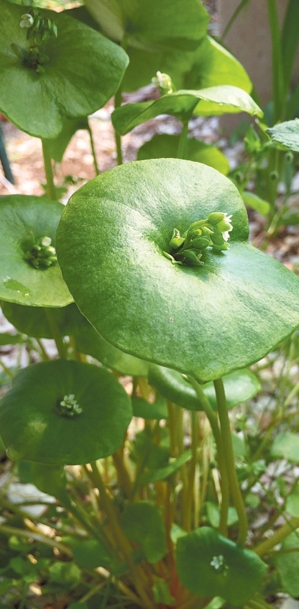Wild Food: Miner’s Lettuce
Farmgirl Confidential
A delicious late winter alternative to nothing, miner’s lettuce (Claytonia perfoliata) is the iceberg lettuce of wild foods, ready to harvest at a time of year when nothing else grows. When you just can’t wait any longer for spring, miner’s lettuce is ready to harvest, even earlier than fiddleheads, chickweed, or mint.
It has “naturalized” in my cold greenhouse, reappearing in late February and March, having that little bit of cover from the elements outside. It grows through the quahog shells on the floor and seems to enjoy the dappled shade under the benches best of all. There it gets the draining water from the seedling flats above and protection from the strengthening February sun.
Incredibly succulent with melt-in-your-mouth texture and a subtle earthy flavor, this raw salad green is not a “last resort” winter vegetable but rather one you’ll be craving all year long. The long, tender stems rise up and pierce through the emerald green leaves like a waiter’s arm holding up a platter. The stems are crunchy and as delicious as the leaf. A sprinkle of sea salt and a drizzle of olive oil turn it into culinary delight. Perhaps only next to watercress, miner’s lettuce is America’s premier wild salad green.
In the 1970s and 80s miner’s lettuce had a surge of popularity during the heyday of Alice Waters and the legendary Chez Panisse’s fresh, local, and sustainable farm-to-table movement in California. And then, it slipped into obscurity, other than within the “wild foraging” circles.
Not a lettuce at all, Claytonia is in the Portulacaceae or purslane family. Native and growing wild in California, particularly abundant in the Pacific Northwest, it was a favorite of the starved forty-niners in the days of the gold rush. Easily encountered and extremely high in vitamin C (a 2-cup single serving contains a third of the daily requirement) it was a lifesaver in preventing scurvy.
Unlike its more common eastern purslane relative, Portulaca oleracea, which was introduced from India and Persia centuries ago and is both an invasive weed and highly nutritional edible plant, miner’s lettuce leaves are refined and delicate, not thick and mucilaginous. The whole plant may be eaten—stem, leaf, and flower. The blossoms are as edible as nasturtiums, which, to me, is a hard find in the edible flower world.
Early European explorers were so impressed with miner’s lettuce that sometime in the late 1700s they collected its seeds and brought them back to Europe where its popularity spread rapidly, as well as its tendency to become a rampant weed in certain moist and temperate climates. This was quite rare for a weed, as almost all of our edible weeds here in North America—dandelion, plantain, purslane, chickweed—are of European origin, brought over as edible plants or hitching rides by attaching their sticky or thistle-like, opportunistic claws on luggage or on ballast rocks in the bilge of ships.
Miner’s lettuce may also be cultivated as a garden green and it is the most reliable, short-day, cold hardy salad producer in the winter. It is grown as a “cut and come again” crop, forming small, neat mounds, each plant providing three to four harvests.
Late winter and spring are its natural season, but that season can be extended simply by planting it in succession, and insuring it is kept moist throughout its growth cycle. Even when in flower it does not become bitter, although in hot weather it tends to wither away, returning once the summer season ends.
Miner’s lettuce self-seeds readily and the seed heads mature quickly on the plant, so that once planted it will reappear season after season with only the most basic protection in our planting zone. A cold frame or unheated greenhouse is as much as it needs here to grow all winter long.
Four to six weeks before the last spring frost, direct seed miner’s lettuce one-quarter inch deep, one half inch apart, in rows eight to 12 inches apart. Make succession plantings from early to mid-spring, and resume plantings in late summer to mid-fall for fall and winter harvest. It is said that the seed may be saved for five years. The plants may over-winter outside in zones 6 and 7 in a protected spot.
Miner’s lettuce is sometimes used, short term (about three months from each sowing), as an ornamental in gardens and flower boxes. It is also helpful in controlling early season invasions of weeds and unwanted grasses in fields and orchards. It thrives in both sun and shade, provided it has adequate moisture.
So mark your calendars in late summer for miner’s lettuce seed sowing. The seeds are tiny, so barely cover them. They do not like root disturbance, so sow in situ. Forty days from seed to salad, miner’s lettuce is truly a native, American edible.




